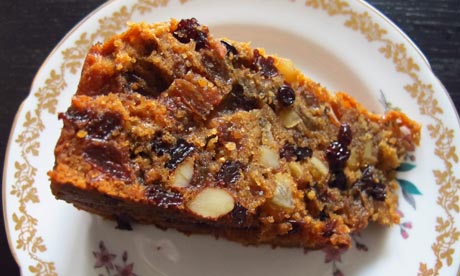How to cook perfect Christmas cake
Should a Christmas cake be dark and rich, or lighter and zestier? And what of those continental contrivances panettone and stollen?
 Felicity’s perfect Christmas cake. Photograph: Felicity Cloake
Felicity’s perfect Christmas cake. Photograph: Felicity Cloake
As the very first real cake I ever baked, Christmas cake occupies a special place in my heart. Admittedly, the result, cruelly dubbed “the rock of ages” by my doting dad, was still going strong long after Easter eggs were old news, but practice makes perfect, and now I’d like to think I was a bit of a dab hand with the old mixed peel.
In these days of triple chocolate yule logs and all-singing, all-dancing pine-scented mince pies, however, the homely fruit cake can suffer from the stigma of overfamiliarity, even an off-putting wholesomeness.
If you find it hard to muster enthusiasm for this most British of baked goods, consider Eliza Acton’s tart observation that “more illness is caused by habitual indulgence in rich and heavier kind of cakes than can easily be credited by persons who have given no attention to the subject.” A peculiarly Victorian dourness aside, the lady has a point: when one stops to consider the ingredients that go into these confections – butter, sugar, eggs, exotic fruits, spices and, of course, booze – they start to seem less the kind of thing one might expect to find in a Girl Guide’s picnic baskets, and more a riot of devil-may-care festive decadence. Which automatically, of course, makes them much more exciting.
Although fruit cakes are fair game from the moment they emerge from the oven (even the raw batter is a treat), as with so many truly great foodstuffs, they actually improve with age, especially if they’re drip-fed with alcohol as they mature. Hence the tradition of Stir-up Sunday, the last before Advent, and as such, the proper time to mix up the holy trinity of festive dried fruit goodies: mincemeat, Christmas pudding and Christmas cake. (The keenest, of course, pooh-pooh such last-minute arrangements – I know some smug sorts who make their puddings ayear in advance.)
Even if you only do one of the three this weekend, it’s still a satisfying way to spend a November afternoon, with the bonus of giving your house an authentically festive scent without so much as a sniff of an eggnog-scented candle or mulled wine “plug-in”.
All rise
Ever since dried fruit first arrived here in the 13th century, the British have baked with it, first in fruit breads, such as bara brith or Lincolnshire plum loaf, and then in cakes which, until relatively recently, would still have been raised with yeast. Eliza Smith’s 1753 “Great cake” calls for 3 pints of the stuff.
By Eliza Acton’s day, however, yeast had been largely replaced by eggs, as in Mr Herbert M Bower’s recipe for Ripon Plum Cake or Christmas Cake, included in Florence White’s 1932 collection, Good Things in England, which contains no fewer than 7, the whites of which must be beaten “to a stiff snow”, rather like a Savoy sponge, before being added to the cake mixture. His cake is a curious one, more sponge than fruit – a summer variation on a fruit cake, perhaps, but not rich enough for this time of year.
Annie Bell uses bicarbonate of soda as the raising agent in the All Gold Christmas cake recipe in her book Gorgeous Christmas – added to a warm pan of melted butter and apple juice, it fizzes spectacularly. The cake has such a featherlight texture that I almost feel as if I’m eating a mouthful of rather delicious fruit, which isn’t quite the point – I think a fruit cake needs a bit more heft.
Baking powder has replaced yeast as the most usual leavening agent for cakes, popping up in Mary Berry’s Victorian Christmas Cake from her Christmas Collection, and legendary pastry chef Claire Clark’s recipe in Indulge as well as Dan Lepard’s Black Christmas Cake and Nigella’s Easy Action Christmas Cake in Feast.
Although the recipes themselves are very different, this seems to give the most consistent texture: fluffy, yet somehow also comfortingly solid, it provides more support for the dried fruit than the bicarb. Lepard uses wholemeal flour, which I think makes his cake unnecessarily heavy however – it’s already squidgy and sodden with fruit and treacle, so why over-egg the pudding (as it were)?
In pursuit of moistness
Both Nigella and Annie Bell’s recipes are for “boiled fruit cakes” – which doesn’t, sadly, mean that the cake has literally been boiled in pursuit of that ultimate moistness, as I first assumed, but that some of the ingredients are boiled during the preparation of the cake. This old trick means that there’s no need to laboriously cream together the butter and sugar, which saves time, or even pre-soak the fruit, as Mary Berry and Claire Clark suggest, and, some claim, gives a lighter, and yes, a moister end result. I’m with them on the moistness – the fruit in both is almost disconcertingly plump, and the crumb sticky and damp but the cakes seem less rich in flavour somehow.
Instead, Mary Queen of Cakes, as I believe she is now officially known in recognition of her stellar performance on the Great British Bake Off, suggests soaking the fruit in sherry for a full three days before baking, while Claire allows overnight soaking, as does Good Food magazine for their Hot Toddy Fruit Cake. Mary’s fruit competes with the boiled sort for plumpness but I find it disconcertingly squidgy: a briefer soaking still leaves it pleasantly boozy without spoiling the texture.
The spirit of Christmas
But what to soak it in? Mary opts for sherry, Annie Bell apple juice, Dan Lepard stout, Nigella rum, Herbert Bower whisky (in fact, lemon whisky, something which appears to be now confined to the Scandinavian market), Good Food magazine tea and whisky, and Claire Clark brandy, rum and orange juice.
It’s easy to strike out apple juice and tea, both of which are too insipid to make much of an impact amongst so many other ingredients. Even the sherry doesn’t stand out. The stout, meanwhile, boiled down until almost syrupy, adds a malty note which works brilliantly with the spicy, treacly gingerbread character of Dan’s cake, but would be a little too savoury with a more conventional recipe.
A spirit seems the best choice here: which one is largely a matter of personal taste. I think whisky works best with dried fruit – rum is slightly too sweet for me, and cheaper brandy (anyone who cooks with a fine calvados or Armagnac won’t be getting a Christmas gift from me) doesn’t have enough character.
Sugar: sweetness, darkness and light
Sweet as dried fruit is, a cake isn’t a cake without sugar. (Unless it’s Annie Bell’s recipe, which opts for ground almonds instead, perhaps explaining its puzzlingly light and troublingly wholesome flavour.) Good Food and Mr Bower opt for caster sugar, which, although the standard choice for baking, doesn’t offer much in the way of extra flavour. Even Mary Berry’s light soft brown sugar is a bit mild – no, what you need here is the dark muscovado employed by Claire Clark and Dan Lepard – although the vast amount of treacle the latter spoons in with it makes it taste more like parkin. I prefer a slightly lighter cake, so, controversially, I’m going to leave treacle out of it altogether.
The special ingredients
The mainstay of the cake, the dried fruit is, I think, largely a matter of taste – in addition to the usual vine fruits, Annie Bell adds dates, Dan Lepard prunes, Herbert Bower and Claire Clark candied peel, Mary Berry glacé cherries, and I like figs – but as long as you chop them up small enough, I leave the combination up to you. Clark, Berry and Bower’s addition of almonds is a happy one; as well as providing an interesting crunch, their mild, milky sweetness is a nice counterpoint to the intensely sugary fruit.
Good Food add marmalade in obedience to their hot toddy theme, while Claire Clark goes for chocolate spread: I can’t detect either in the final cakes, unlike Nigella’s chestnut purée, which has given her cake an odd, slightly furry, almost claggy texture which I’m not too keen on. Innovation doesn’t have much place in a Christmas cake as far as I’m concerned.
Perfect Christmas cake
A Christmas cake should be rich and spicy; bursting with boozy fruit but never, ever heavy. After all, you need to leave room for a mince pie.
250g currants
250g sultanas
100g dried figs, roughly chopped
100g glacé cherries, cut in half
100g mixed peel
125ml whisky, plus extra to feed
125g butter, softened
125g muscovado sugar
4 eggs, beaten
130g plain flour
½ tsp baking powder
1 tsp mixed spice
50g ground almonds
Grated zest of 1 lemon
50g whole almonds
25g crystallised ginger, chopped
1. Put the dried fruit and peel in a bowl along with the whisky, cover and leave to soak overnight. Stir well before use. Grease and line a 20cm cake tin with 2 layers of baking parchment.
2. Preheat the oven to 140C. Cream together the butter and sugar until light and fluffy, then gradually add the eggs, beating well after each addition so the mixture doesn’t curdle.
3. Mix together the sifted flour, baking powder, spice, ground almonds and a pinch of salt and then fold this into the butter and sugar mixture. Add the soaked fruits, and any remaining whisky, the lemon zest, chopped almonds and ginger, and stir to combine.
4. Tip the mixture into your prepared tin and smooth the surface, scooping out a small hollow in the middle to prevent a doming effect.
5. Put the cake in the oven for about an hour, then cover with foil, and bake for another 30 minutes and then check the cake. It’s done when a skewer inserted into the middle comes out clean – check every 10 minutes until it’s cooked.
6. Leave to cool in the tin then use the skewer to poke a few holes almost all the way through the cake, and brush them with more whisky. With the baking parchment still attached, wrap well in greaseproof paper and store in an airtight tin or a layer of foil, repeating the feeding every week or so until you’re ready to ice just before Christmas. (I’d recommend Nigel Slater’s instructions on these matters.)
Do you still like fruit cake, or are you more partial to panettone or seduced by stollen? Do you prefer them dark and rich, or lighter and zestier – and am I only the only person who loves the marzipan best of all?


